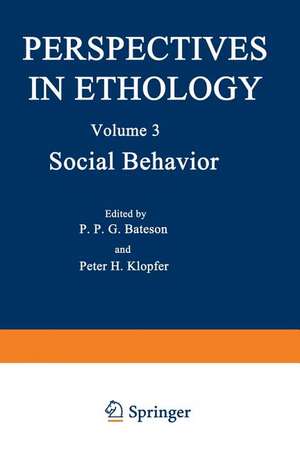Social Behavior: Perspectives in Ethology, cartea 3
Editat de P. Batesonen Limba Engleză Paperback – 27 dec 2012
Preț: 638.89 lei
Preț vechi: 751.64 lei
-15% Nou
Puncte Express: 958
Preț estimativ în valută:
122.29€ • 132.88$ • 102.79£
122.29€ • 132.88$ • 102.79£
Carte tipărită la comandă
Livrare economică 21 aprilie-05 mai
Preluare comenzi: 021 569.72.76
Specificații
ISBN-13: 9781468429039
ISBN-10: 1468429035
Pagini: 280
Ilustrații: XIII, 263 p.
Dimensiuni: 152 x 229 x 15 mm
Greutate: 0.38 kg
Ediția:Softcover reprint of the original 1st ed. 1978
Editura: Springer Us
Colecția Springer
Seria Perspectives in Ethology
Locul publicării:New York, NY, United States
ISBN-10: 1468429035
Pagini: 280
Ilustrații: XIII, 263 p.
Dimensiuni: 152 x 229 x 15 mm
Greutate: 0.38 kg
Ediția:Softcover reprint of the original 1st ed. 1978
Editura: Springer Us
Colecția Springer
Seria Perspectives in Ethology
Locul publicării:New York, NY, United States
Public țintă
ResearchCuprins
1 The Genetics of Social Behavior.- I. Introduction.- II. The Genetic Roulette Wheel.- III. The Tender Trap of Adaptation.- IV. The Problem of Homogeneity.- V. Nonrandom Sampling of Restricted Gene Pools.- VI. The Evolutionary Advantages of Social Behavior.- VII. Acknowledgments.- VIII. References.- 2 The Ecological Significance of Behavioral Dominance.- I. Introduction.- II. Historical Considerations.- III. Behavioral Dominance as a Natural Regulatory System.- IV. The Dominance-Dispersal Model.- V. Supportive Data and Discussion.- VI. Summary.- VII. Acknowledgments.- VIII. References.- 3 How Does Behavior Develop?.- I. Abstract.- II. Introduction.- III. Discontinuities in Development.- IV. Explanations for Discontinuities.- V. Conclusion.- VI. Acknowledgments.- VII. References.- 4 Continuity and Stage in Human Development.- I. The Meanings of Continuity.- II. Continuity in Stage Theory.- III. The Historical Bases for Faith in Continuity.- IV. Evidence for Continuity in Human Development.- V. Acknowledgments.- VI. References.- 5 Feeding Behavior of Lemur Catta in Different Habitats.- I. Introduction.- II. Description of the Habitat.- III. Lemur Behavior.- IV. Discussion.- V. Acknowledgments.- VI. References.- 6 Status and Hierarchy in Nonhuman Primate Societies.- I. Definitions.- II. A Straw-Man Theory.- III. Triadic Processes—One Alternative.- IV. Is Dominance Natural?.- V. Dominance or Subordinance?.- VI. Stress, Status, and Learning.- VII. Questions of Function.- VIII. Hierarchy Formation and Mathematics.- IX. Summary.- X. Acknowledgments.- XI. References.- 7 Hidden Regulatory Processes in Early Social Relationships.- I. Abstract.- II. Introduction.- III. Olfactory Processes Regulating the Mother-Infant Interaction.- IV. Regulation of the Infants’ AutonomicFunction by the Mothers’ Milk.- V. Infant Behavioral Arousal.- VI. Regulation of Rhythmic Functions of the Infant.- VII. Implications for Infant Development.- VIII. References.- 8 Social Behavior on Islands.- I. Introduction.- II. Behaving in the Caribbean.- III. Island Influences on Biota.- IV. Behavioral Traits of Colonizers.- V. The Effect of Wide Niches on Behavior.- VI. Aggression on Islands.- VII. The Behavioral Effects of Increased Numbers on Islands.- VIII. The Relative Social Effects of Competition and Predation on Islands.- IX. Multiple Invasions, Populations, and Niche Size.- X. Shallow Island Niches.- XI. Behavioral Correlates of Niche Broadening.- XII. Summary.- XIII. References.- 9 On Predation, Competition, and the Advantages of Group Living.- I. Abstract.- II. Introduction.- III. The Major Selective Forces.- IV. Predation and Resource Competition: Influences of Environment, Individuals, and Species.- V. Predation and Resource Competition: Their Combined Action.- VI. Discussion and Conclusions.- VII. Acknowledgments.- VIII. Appendix—Glossary of Terms.- IX. References.- 10 Is History a Consequence of Evolution?.- I. Abstract.- II. Introduction.- III. Causality in Evolution and History.- IV. Evolution Considered as an Existential Game.- V. The Peculiar Evolutionary Strategy of Man.- VI. Residual Evolutionary Problems.- VII. Acknowledgments.- VIII. References.










